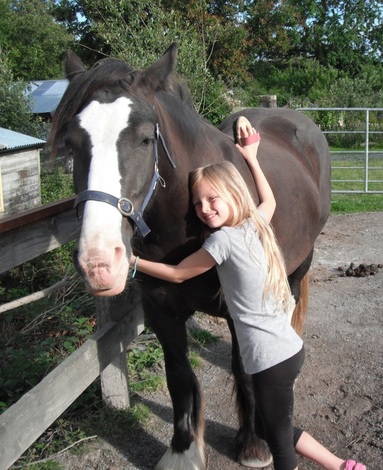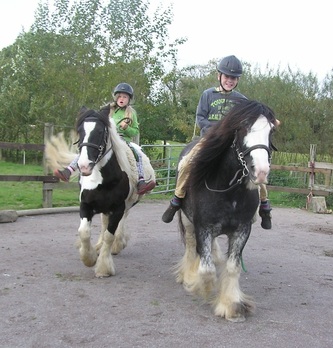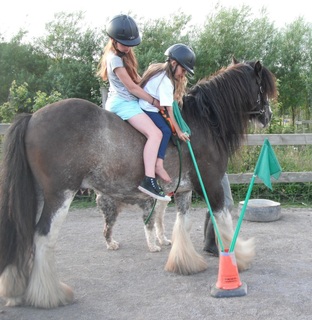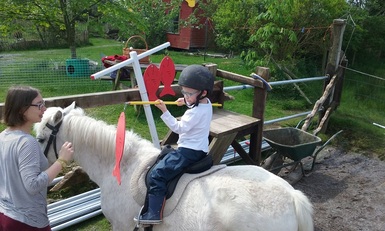Our Approach
Professional Background
The professional approach used at Hairy Henry's is based on Sandra's interdisciplinary training, which includes her formative studies in Applied Social Studies and Social Pedagogy, her further studies in Outdoor and Nature Education, Experiential Learning, Disability Awareness, Child Development, Autism Studies and Equine Assisted Learning.
Her training in Therapeutic Riding helped Sandra to combine her academic knowledge and professional skills to develop her unique approach which she uses for her therapeutic work at Hairy Henry's.
Sandra uses a range of methods based on the works of Carl Rogers (Person-centred Approach), Howard Gardner (Theory of Multiple Intelligences), D. Kolb (Experiential Learning), E.O. Wilson (Biophilia Hypothesis - instinctive bond between human beings and other living systems), based on research carried out by Temple Grandin (on the effectiveness of human-animal interaction on stress-reduction and learning) and Rupert Isaacson's Horse Boy Method.
The theories and methods behind Sandra's work provide her with a framework to promote development and learning.They cannot be seen in isolation but are used in combination, to maximise the benefits for the participant, using their particular strengths and meeting their individual needs.
The therapeutic work at Hairy Henry's focuses on these four elements:
Her training in Therapeutic Riding helped Sandra to combine her academic knowledge and professional skills to develop her unique approach which she uses for her therapeutic work at Hairy Henry's.
Sandra uses a range of methods based on the works of Carl Rogers (Person-centred Approach), Howard Gardner (Theory of Multiple Intelligences), D. Kolb (Experiential Learning), E.O. Wilson (Biophilia Hypothesis - instinctive bond between human beings and other living systems), based on research carried out by Temple Grandin (on the effectiveness of human-animal interaction on stress-reduction and learning) and Rupert Isaacson's Horse Boy Method.
The theories and methods behind Sandra's work provide her with a framework to promote development and learning.They cannot be seen in isolation but are used in combination, to maximise the benefits for the participant, using their particular strengths and meeting their individual needs.
The therapeutic work at Hairy Henry's focuses on these four elements:
- Relationship
- Movement
- Experiential learning
- Communication
Relationship
At Hairy Henry's, not only the relationship between participant and coach is important for successful therapeutic work, but the relationship that is formed over time with the animals here is an essential part.
Trust building
When people struggle to form meaningful friendships with others; when people have been traumatised by stressful, violent or abusive contact with others; when people have low self-esteem and a poor image of themselves and thus do not have the confidence to form positive relationships with others; when people struggle with sensory overload, confusion, defensive or destructive behaviour when confronted with social contact with others - animals can take on an important role. They can play an essential part in building trust, self-esteem and social skills and offer new and positive experiences of friendship.
Closeness
Animals can help bridge the - physical, emotional and mental - distance between living beings. Without prior judgement or prejudice, they often ask for social contact and closeness - out of curiosity, interest, playfulness, attention-seeking or the need to be cared for.
Especially horses are extremely caring and social creatures. They nurture their young against all odds, and they transfer this instinctive generosity to us humans - they are prepared to stand by us and carry us 'through thick and thin'.
But they also demand from us responsibility and courage.
Sense of responsibilty
We need to be responsible in our task of caring for the animals. They depend on us for food and water, shelter and medical care. Caring for another being demands commitment and selflessness, but it gives us a sense of contentment and importance, fulfilment and empathy
.
Courage and empowerment
When we handle a strong animal that weighs up to 12 times as much as ourselves and is 10 times stronger than us, we need to be brave and learn to cope with the challenge to get this strong creature on our side. This motivates us to step out of our comfort zone where real growth can happen.
People benefit from the sense of empowerment, care and empathy that the close contact with our animals can bring. Children and adolescents benefit especially from forming a relationship with our animals, as they can meet their needs for affection, confidence, companionship, unconditional joy and warmth in a non-judgemental unconditional context.
Trust building
When people struggle to form meaningful friendships with others; when people have been traumatised by stressful, violent or abusive contact with others; when people have low self-esteem and a poor image of themselves and thus do not have the confidence to form positive relationships with others; when people struggle with sensory overload, confusion, defensive or destructive behaviour when confronted with social contact with others - animals can take on an important role. They can play an essential part in building trust, self-esteem and social skills and offer new and positive experiences of friendship.
Closeness
Animals can help bridge the - physical, emotional and mental - distance between living beings. Without prior judgement or prejudice, they often ask for social contact and closeness - out of curiosity, interest, playfulness, attention-seeking or the need to be cared for.
Especially horses are extremely caring and social creatures. They nurture their young against all odds, and they transfer this instinctive generosity to us humans - they are prepared to stand by us and carry us 'through thick and thin'.
But they also demand from us responsibility and courage.
Sense of responsibilty
We need to be responsible in our task of caring for the animals. They depend on us for food and water, shelter and medical care. Caring for another being demands commitment and selflessness, but it gives us a sense of contentment and importance, fulfilment and empathy
.
Courage and empowerment
When we handle a strong animal that weighs up to 12 times as much as ourselves and is 10 times stronger than us, we need to be brave and learn to cope with the challenge to get this strong creature on our side. This motivates us to step out of our comfort zone where real growth can happen.
People benefit from the sense of empowerment, care and empathy that the close contact with our animals can bring. Children and adolescents benefit especially from forming a relationship with our animals, as they can meet their needs for affection, confidence, companionship, unconditional joy and warmth in a non-judgemental unconditional context.
Movement
Movement is an important element in human development and learning, especially in early childhood development. Children develop their motor and cognitive skills through movement, and they learn about themselves and their environment by moving around and exploring.
Neuro-muscular stimulation
Horseback riding triggers between 90 to 110 3-dimensional muscular and joint movements in a rider. These movements can contribute significantly to stimulating our neuro-muscular system, to developing our sense of balance and spatial orientation through the vestibular system, and to developing our sense of proprioception - in order to learn to move our bodies and limbs accurately.
Motivation
The horse can act as a huge motivator - especially with people who have become less motivated by a typical clinical indoor setting. The horse acts as a partner in the physical process of riding, and the benefits of being carried and moved around by a horse happen naturally whilst the rider engages in the therapy session.
We integrate recommendations made by the participant's Occupational Therapist or Physiotherapist into our activities and games to maximise the benefits of our session.
Flexibility, core strength and balance
Furthermore, the movement of the walking horse stimulates the rider's body in a similar way as walking would do. This plays an important role especially in riders who have difficulties walking and keeping balance. Walking independently may be a struggle for them and they may find it very challenging to keep on practising on a daily basis. When on horseback, the horse's gait moves their hips and pelvis in a similar way, whilst the rider can relax into the sensation of being carried. This movement exercises and builds the rider's core muscles which can help significantly in their progress to learn to walk independently.
Learning through movement
It is widely known that every individual learns differently. Some struggle with the conventional classroom type educational approach because it involves so much sitting still and listening.
At Hairy Henry's we promote movement and the benefits this can bring to people's educational progress. People are encouraged to move as much as they need to, in order to be able to focus on an exercise or game. Movement is an essential part of our activities and our sessions are layed out in a way that meets people's individual need for movement.
Relaxation and stress reduction
Especially with people whose stress levels are raised (as often found in people with ASD or ADHA, PTSD and Attachment Disorder), movement can be a first step to reduce stress. Stress is caused by an abundance of cortisol in one's system, and this causes the brain to switch to its 'fight or flight' mode. In this state, concentrating and learning new things can be extremely difficult, if not impossible. Physical movement helps reduce the cortisol levels in the body, and combined with relaxing sensory input - being rocked in the saddle by a horse, feeling the warmth and softness of an animal, being in a calm outdoor environment with few potentially stressful sensory triggers - this can lead to a much more relaxed state of mind, where learning becomes possible again.
Neuro-muscular stimulation
Horseback riding triggers between 90 to 110 3-dimensional muscular and joint movements in a rider. These movements can contribute significantly to stimulating our neuro-muscular system, to developing our sense of balance and spatial orientation through the vestibular system, and to developing our sense of proprioception - in order to learn to move our bodies and limbs accurately.
Motivation
The horse can act as a huge motivator - especially with people who have become less motivated by a typical clinical indoor setting. The horse acts as a partner in the physical process of riding, and the benefits of being carried and moved around by a horse happen naturally whilst the rider engages in the therapy session.
We integrate recommendations made by the participant's Occupational Therapist or Physiotherapist into our activities and games to maximise the benefits of our session.
Flexibility, core strength and balance
Furthermore, the movement of the walking horse stimulates the rider's body in a similar way as walking would do. This plays an important role especially in riders who have difficulties walking and keeping balance. Walking independently may be a struggle for them and they may find it very challenging to keep on practising on a daily basis. When on horseback, the horse's gait moves their hips and pelvis in a similar way, whilst the rider can relax into the sensation of being carried. This movement exercises and builds the rider's core muscles which can help significantly in their progress to learn to walk independently.
Learning through movement
It is widely known that every individual learns differently. Some struggle with the conventional classroom type educational approach because it involves so much sitting still and listening.
At Hairy Henry's we promote movement and the benefits this can bring to people's educational progress. People are encouraged to move as much as they need to, in order to be able to focus on an exercise or game. Movement is an essential part of our activities and our sessions are layed out in a way that meets people's individual need for movement.
Relaxation and stress reduction
Especially with people whose stress levels are raised (as often found in people with ASD or ADHA, PTSD and Attachment Disorder), movement can be a first step to reduce stress. Stress is caused by an abundance of cortisol in one's system, and this causes the brain to switch to its 'fight or flight' mode. In this state, concentrating and learning new things can be extremely difficult, if not impossible. Physical movement helps reduce the cortisol levels in the body, and combined with relaxing sensory input - being rocked in the saddle by a horse, feeling the warmth and softness of an animal, being in a calm outdoor environment with few potentially stressful sensory triggers - this can lead to a much more relaxed state of mind, where learning becomes possible again.
Experiential Learning
At Hairy Henry's we do not only promote stress-reduction and learning at everyone's individual pace, but also experiential learning.
People are encouraged to learn through their reflection on what they have achieved so far. At first, this could be reviewing a simple practical task relating to the different jobs at Hairy Henry's. When more familiar with this concept of learning, it could be a broader and more complex issue in school, at home, with friends.
We help people to look at an issue reflectively:
1. What have I done/achieved? What exactly happened?
2. What does this mean to me? How do I feel about it?
3. What could I have done differently? What went well, what didn't go so well?
4. What could I change for next time to do a better job/ to not get into trouble/to avoid that things go wrong?
This reflective approach is practised first with hands-on straight-forward tasks like leading the horse from the field to the yard, picking the horse's hooves, cleaning out the stables etc., and we then help the participant to transfer this approach to other more complex situations.
In this context, we create opportunities for self-development and problem-solving, with the horse or other farm animal acting as the catalyst in the process.
The animal is a partner rather than a tool - they motivate people to act and interact, to care, bond, experience pleasant or not so pleasant feelings. We use this motivation for participants to learn through reflection, explore, develop and try new things.
People are encouraged to learn through their reflection on what they have achieved so far. At first, this could be reviewing a simple practical task relating to the different jobs at Hairy Henry's. When more familiar with this concept of learning, it could be a broader and more complex issue in school, at home, with friends.
We help people to look at an issue reflectively:
1. What have I done/achieved? What exactly happened?
2. What does this mean to me? How do I feel about it?
3. What could I have done differently? What went well, what didn't go so well?
4. What could I change for next time to do a better job/ to not get into trouble/to avoid that things go wrong?
This reflective approach is practised first with hands-on straight-forward tasks like leading the horse from the field to the yard, picking the horse's hooves, cleaning out the stables etc., and we then help the participant to transfer this approach to other more complex situations.
In this context, we create opportunities for self-development and problem-solving, with the horse or other farm animal acting as the catalyst in the process.
The animal is a partner rather than a tool - they motivate people to act and interact, to care, bond, experience pleasant or not so pleasant feelings. We use this motivation for participants to learn through reflection, explore, develop and try new things.
Communication
Non-verbal communication
We communicate on many different levels - verbal communication only plays a small part in this. A lot of our communication is non-verbal - facial expression, body language, body tone. Animals, in particular horses, are very sensitive to this form of non-verbal communication and respond to it. By reading and interpreting the reaction of the horse, we can learn a lot about people's state of mind, their emotions and their intentions. At Hairy Henry's we use this feedback from the horse to understand our participants better. In return, the participant can learn a lot about themselves from the reaction of the horse. This creates opportunities for self-development - confidence, assertiveness, leadership skills, impulse control, anger management.
Direct and honest feedback
The interaction and communication with horses gives us the opportunity to return to early childhood experiences of physical closeness without condition and clear direct communication without second agenda. We learn about ourselves and the world around us, as the horse is non-judgemental and gives honest feedback. The attention and companionship a horse offers is unconditional and genuine, and therefore experiences with horses often have a significant meaning for people.
Verbal communication and social skills
By practising how to communicate with the horse, we will assist people to learn how to apply these same skills in inter-personal relationships. Learning about non-verbal communication skills can help enhance self-awareness and can help to communicate more effectively.
Language development
In our work with younger children, where verbal communication is delayed or difficult, we work with visual aids in order to encourage language development. We aim to incorporate approaches in our work which are already used by the child's Speech and Language Therapist, such as PECS.
We communicate on many different levels - verbal communication only plays a small part in this. A lot of our communication is non-verbal - facial expression, body language, body tone. Animals, in particular horses, are very sensitive to this form of non-verbal communication and respond to it. By reading and interpreting the reaction of the horse, we can learn a lot about people's state of mind, their emotions and their intentions. At Hairy Henry's we use this feedback from the horse to understand our participants better. In return, the participant can learn a lot about themselves from the reaction of the horse. This creates opportunities for self-development - confidence, assertiveness, leadership skills, impulse control, anger management.
Direct and honest feedback
The interaction and communication with horses gives us the opportunity to return to early childhood experiences of physical closeness without condition and clear direct communication without second agenda. We learn about ourselves and the world around us, as the horse is non-judgemental and gives honest feedback. The attention and companionship a horse offers is unconditional and genuine, and therefore experiences with horses often have a significant meaning for people.
Verbal communication and social skills
By practising how to communicate with the horse, we will assist people to learn how to apply these same skills in inter-personal relationships. Learning about non-verbal communication skills can help enhance self-awareness and can help to communicate more effectively.
Language development
In our work with younger children, where verbal communication is delayed or difficult, we work with visual aids in order to encourage language development. We aim to incorporate approaches in our work which are already used by the child's Speech and Language Therapist, such as PECS.
Text and images: Copyright Sandra Schmid 2016




